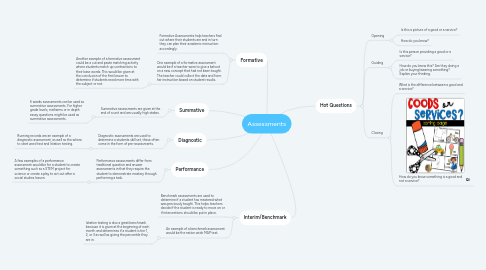
1. Formative
1.1. Formative Assessments help teachers find out where their students are and in turn they can plan their academic instruction accordingly.
1.2. One example of a formative assessment would be if a teacher were to give a kahoot on a new concept that had not been taught. The teacher could collect the data and form her instruction based on student results.
1.2.1. Another example of a formative assessment could be a cut and paste matching activity where students match up contractions to their base words. This would be given at the conclusion of the first lesson to determine if students need more time with the subject or not.
2. Interim/Benchmark
2.1. Benchmark assessments are used to determine if a student has mastered what was previously taught. This helps teachers decide if the student is ready to move on or if interventions should be put in place.
2.2. An example of a benchmark assessment would be the nation wide MAP test.
2.2.1. Istation testing is also a great benchmark because it is given at the beginning of each month and determines if a student is tier 1, 2, or 3 as well as giving the percentile they are in.
3. Summative
3.1. Summative assessments are given at the end of a unit and are usually high stakes.
3.1.1. 6 weeks assessments can be used as summative assessments. For higher grade levels, midterms or in depth essay questions might be used as summative assessments.
4. Diagnostic
4.1. Diagnostic assessments are used to determine a students skill set, these often come in the form of pre-assessments.
4.1.1. Running records are an example of a diagnostic assessment, as well as the where to start word test and Istation testing.
5. Performance
5.1. Performance assessments differ from traditional question and answer assessments in that they require the student to demonstrate mastery through performing a task.
5.1.1. A few examples of a performance assessment would be for a student to create something such as a STEM project for science or create a play to act out after a social studies lesson.
6. Hot Questions
6.1. Opening
6.1.1. Is this a picture of a good or a service?
6.1.2. How do you know?
6.2. Guiding
6.2.1. Is this person providing a good or a service?
6.2.2. How do you know this? Are they doing a job or buying/wearing something? Explain your thinking.
6.3. Closing
6.3.1. What is the difference between a good and a service?
6.3.2. How do you know something is a good and not a service?

